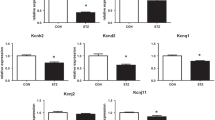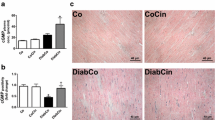Abstract
We have previously shown that chronic treatment with propranolol had beneficial effects on heart function in rats during increasing-age in a gender-dependent manner. Herein, we hypothesize that propranolol would improve cardiac function in diabetic cardiomyopathy and investigated the benefits of chronic oral administration of propranolol on the parameters of Ca2+ signaling in the heart of streptozotocin-diabetic rats. Male diabetic rats received propranolol (25 mg/kg, daily) for 12 weeks, 1 week after diabetes induction. Treatment of the diabetic rats with propranolol did not produce a hypoglycaemic effect whereas it attenuated the increased cell size. Basal and β-agonist response levels of left ventricular developed pressure were significantly higher in propranolol-treated diabetic rats relative to untreated diabetics while left ventricular end diastolic pressure of the treated diabetics was comparable to the controls. Propranolol treatment normalized also the prolongation of the action potential in papillary muscles from the diabetic rat hearts. This treatment attenuated the parameters of Ca2+ transients, depressed Ca2+ loading of the sarcoplasmic reticulum, and of the basal intracellular Ca2+ level of diabetic cardiomyocytes. Furthermore, Western blot data indicated that the diabetes-induced alterations in the cardiac ryanodine receptor Ca2+ release channel’s hyperphosphorylation decreased the FKBP12.6 protein level. Also, the high phosphorylated levels of PKA and CaMKII were prevented with propranolol treatment. Chronic treatment with propranolol seems to prevent diabetes-related changes in heart function by controlling intracellular Ca2+ signaling and preventing the development of left ventricular remodeling in diabetic cardiomyopathy.
Similar content being viewed by others
References
Ahmet I, Krawczyk M, Zhu W, Woo AY, Morrell C, Poosala S, Xiao RP, Lakatta EG, Talan MI (2008) Cardioprotective and survival benefits of long-term combined therapy with beta2 adrenoreceptor (AR) agonist and beta1 AR blocker in dilated cardiomyopathy postmyocardial infarction. J Pharmacol Exp Ther 325(2):491–499
Angeli F, Verdecchia P, Karthikeyan G, Mazzotta G, Gentile G, Reboldi G (2010) ß-blockers reduce mortality in patients undergoing high-risk non-cardiacsurgery. Am J Cardiovasc Drugs 10(4):247–259
Aydemir-Koksoy A, Bilginoglu A, Sariahmetoglu M, Schulz R, Turan B (2010) Antioxidant treatment protects diabetic rats from cardiac dysfunction by preserving contractile protein targets of oxidative stress. J Nutr Biochem 21(9):827–833
Bidasee KR, Nallani K, Besch HR Jr, Dincer UD (2003) Streptozotocin-induced diabetes increases disulfide bond formation on cardiac ryanodine receptor (RyR2). J Pharmacol Exp Ther 305(3):989–998
Bilginoglu A, Seymen A, Tuncay E, Zeydanli E, Aydemir-Koksoy A, Turan B (2009) Antioxidants but not doxycycline treatments restore depressed beta-adrenergic responses of the heart in diabetic rats. CardiovascToxicol 9(1):21–29
Choi KM, Zhong Y, Hoit BD, Grupp IL, Hahn H, Dilly KW, Guatimosim S, Lederer WJ, Matlib MA (2002) Defective intracellular Ca(2+) signaling contributes to cardiomyopathy in type 1 diabetic rats. Am J Physiol Heart Circ Physiol 283(4):H1398–H1408
Communal C, Singh K, Sawyer DB, Colucci WS (1999) Opposing effects of beta(1)- and beta(2)-adrenergic receptors on cardiac myocyte apoptosis: role of a pertussis toxin-sensitive G protein. Circulation 100(22):2210–2212
Conlon D, Johnston A, O’Malley K, Turner P, Kilfeather S (1995) Effect of ageing and propranolol administration on myocardial beta-adrenoceptor receptor function in mature rats. Eur J Pharmacol 289(2):283–290
Djanani A, Kaneider NC, Meierhofer C, Sturn D, Dunzendorfer S, Allmeier H, Wiedermann CJ (2003) Inhibition of neutrophil migration and oxygen free radical release by metipranolol and timolol. Pharmacology 68(4):198–203
Doi M, Yano M, Kobayashi S, Kohno M, Tokuhisa T, Okuda S, Suetsugu M, Hisamatsu Y, Ohkusa T, Kohno M, Matsuzaki M (2002) Propranolol prevents the development of heart failure by restoring FKBP12.6-mediated stabilization of ryanodine receptor. Circulation 105(11):1374–1379
Fein FS, Kornstein LB, Strobeck JE, Capasso JM, Sonnenblick EH (1980) Altered myocardial mechanics in diabetic rats. Circ Res 47(6):922–933
Ganguly PK, Pierce GN, Dhalla KS, Dhalla NS (1983) Defective sarcoplasmic reticular calcium transport in diabetic cardiomyopathy. Am J Physiol 244(6):E528–E535
Guatimosim S, Dilly K, Santana LF, SaleetJafri M, Sobie EA, Lederer WJ (2002) Local Ca(2+) signaling and EC coupling in heart: Ca(2+) sparks and the regulation of the [Ca(2+)](i) transient. J Mol Cell Cardiol 34(8):941–950
Hjalmarson A, Goldstein S, Fagerberg B et al (2000) Effects of controlled-release metoprolol on total mortality, hospitalizations, and well-being in patients with heart failure: the metoprolol CR/XL randomized intervention trial in congestive heart failure (MERIT-HF). MERIT-HF study group. JAMA 283(10):1295–1302
Kandilci HB, Tuncay E, Zeydanli EN, Sozmen NN, Turan B (2011) Age-related regulation of excitation-contraction coupling in rat heart. J Physiol Biochem 67(3):317–330
Kubo H, Margulies KB, Piacentino V 3rd, Gaughan JP, Houser SR (2001) Patients with end-stage congestive heart failure treated with beta-adrenergic receptor antagonists have improved ventricular myocyte calcium regulatory protein abundance. Circulation 104(9):1012–1018
López-López JR, Shacklock PS, Balke CW, Wier WG (1995) Local calcium transients triggered by single L-type calcium channel currents in cardiac cells. Science 268(5213):1042–1045
Magyar J, Rusznák Z, Szentesi P, Szûcs G, Kovács L (1992) Action potentials and potassium currents in rat ventricular muscle during experimental diabetes. J Mol Cell Cardiol 24(8):841–853
Marx SO, Reiken S, Hisamatsu Y, Jayaraman T, Burkhoff D, Rosemblit N, Marks AR (2000) PKA phosphorylation dissociates FKBP12.6 from the calcium release channel (ryanodine receptor): defective regulation in failing hearts. Cell 101(4):365–376
Metra M, Covolo L, Pezzali N et al (2010) Role of beta-adrenergic receptor gene polymorphisms in the long-term effects of beta-blockade with carvedilol in patients with chronic heart failure. Cardiovasc Drugs Ther 24(1):49–60
Miyamoto N, Izumi H, Miyamoto R, Kubota T, Tawara A, Sasaguri Y, Kohno K (2009) Nipradilol and timolol induce Foxo3a and peroxiredoxin 2 expression and protect trabecular meshwork cells from oxidative stress. Invest Ophthalmol Vis Sci 50(6):2777–2784
Mochizuki M, Yano M, Oda T, Tateishi H, Kobayashi S, Yamamoto T, Ikeda Y, Ohkusa T, Ikemoto N, Matsuzaki M (2007) Scavenging free radicals by low-dose carvedilol prevents redox-dependent Ca2+ leak via stabilization of ryanodine receptor in heart failure. J Am Coll Cardiol 49(16):1722–1732
Pierce GN, Kutryk MJ, Dhalla NS (1983) Alterations in Ca2+ binding by and composition of the cardiac sarcolemmal membrane in chronic diabetes. Proc NatlAcadSci USA 80(17):5412–5416 [PubMed: 6577435]
Reiken S, Wehrens XH, Vest JA, Barbone A, Klotz S, Mancini D, Burkhoff D, Marks AR (2003) Beta-blockers restore calcium release channel function and improve cardiac muscle performance in human heart failure. Circulation 107(19):2459–2466
Rubler S, Dlugash J, Yuceoglu YZ, Kumral T, Branwood AW, Grishman A (1972) New type of cardiomyopathy associated with diabetic glomerulosclerosis. Am J Cardiol 30(6):595–602
Shan J, Betzenhauser MJ, Kushnir A, Reiken S, Meli AC, Wronska A, Dura M, Chen BX, Marks AR (2010) Role of chronic ryanodine receptor phosphorylation in heart failure and β-adrenergic receptor blockade in mice. J Clin Invest 120(12):4375–4387
Sharma V, Dhillon P, Wambolt R, Parsons H, Brownsey R, Allard MF, McNeill JH (2008) Metoprolol improves cardiac function and modulates cardiac metabolism in the streptozotocin-diabetic rat. Am J Physiol Heart Circ Physiol 294(4):H1609–H1620
Sozmen NN, Tuncay E, Bilginoglu A, Turan B (2011) Profound cardioprotection with timolol in a female rat model of aging-related altered left ventricular function. Can J Physiol Pharmacol 89(4):277–288
Tuncay E, Seymen AA, Tanriverdi E, Yaras N, Tandogan B, Ulusu NN, Turan B (2007) Gender related differential effects of omega-3E treatment on diabetes-induced left ventricular dysfunction. Mol Cell Biochem 304(1–2):255–263
Tuncay E, Seymen AA, Sam P, Gurdal H, Turan B (2009) Effects of beta-adrenergic receptor blockers on cardiac function: a comparative study in male versus female rats. Can J Physiol Pharmacol 87(4):310–317
Turan B, Désilets M, Açan LN, Hotomaroglu O, Vannier C, Vassort G (1996) Oxidative effects of selenite on rat ventricular contractility and Ca movements. Cardiovasc Res 32(2):351–361
Ulusu NN, Turan B (2005) Beneficial effects of selenium on some enzymes of diabetic rat heart. Biol Trace Elem Res 103(3):207–216
Wang R, Miura T, Harada N, Kametani R, Shibuya M, Fukagawa Y, Kawamura S, Ikeda Y, Hara M, Matsuzaki M (2006) Pleiotropic effects of the beta-adrenoceptor blocker carvedilol on calcium regulation during oxidative stress-induced apoptosis in cardiomyocytes. J Pharmacol Exp Ther 318(1):45–52
Wehrens XH, Marks AR (2003) Altered function and regulation of cardiac ryanodine receptors in cardiac disease. Trends Biochem Sci 28(12):671–678
Yaras N, Ugur M, Ozdemir S, Gurdal H, Purali N, Lacampagne A, Vassort G, Turan B (2005) Effects of diabetes on ryanodine receptor Ca release channel (RyR2) and Ca2+ homeostasis in rat heart. Diabetes 54(11):3082–3088
Yaras N, Tuncay E, Purali N, Sahinoglu B, Vassort G, Turan B (2007) Sex-related effects on diabetes-induced alterations in calcium release in the rat heart. Am J Physiol Heart Circ Physiol 293(6):H3584–H3592 [PubMed: 17890429]
Yoshida A, Takahashi M, Imagawa T, Shigekawa M, Takisawa H, Nakamura T (1992) Phosphorylation of ryanodine receptors in rat myocytes during beta-adrenergic stimulation. J Biochem 111(2):186–190
Zeydanli EN, Kandilci HB, Turan B (2011) Doxycycline ameliorates vascular endothelial and contractile dysfunction in the thoracic aorta of diabetic rats. CardiovascToxicol 11(2):134–147
Author information
Authors and Affiliations
Corresponding author
Rights and permissions
About this article
Cite this article
Tuncay, E., Zeydanli, E.N. & Turan, B. Cardioprotective effect of propranolol on diabetes-induced altered intracellular Ca2+ signaling in rat. J Bioenerg Biomembr 43, 747–756 (2011). https://doi.org/10.1007/s10863-011-9400-5
Received:
Accepted:
Published:
Issue Date:
DOI: https://doi.org/10.1007/s10863-011-9400-5




